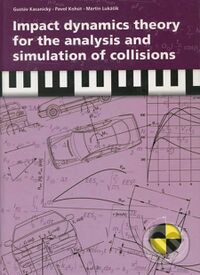Impact dynamics theory for the analysis and simulation of collisions
Zitat
Kasanicky, G.; Kohút, P.; Lukasik, M.: Impact dynamics theory for the analysis and simulation of collisions. Universität Zilina, 1. Auflage 2004, 330 Seiten, ISBN 80-8070-312-4, 99,- € incl. VAT/MWSt. and forwarding expenses.
Erhältlich bei Ing.-Büro Priester / Kasanicky, Angela-Braun-Str. 16, D-66115 Saarbrücken, Mail: info-at-unfallgutachter.de , web: http://www.unfallgutachter.de
https://www.martinus.sk/?uItem=310347
Inhaltsangabe
Anders als der Titel vermuten lässt, beschränkt sich das Buch nicht auf Kollisionsmechanik, sondern erläutert im Wesentlich die in PC-Crash verwendeten Modelle, Stand Anfang der Nuller Jahre. Konsequenterweise wird im Rahmen der Kollisionsmechanik vor allem die Vorwärtsrechenmodelle erörtert, während die Rüchwärtsrechnung unter Simplified methods for impact dynamics calculation nur kurz gestreift wird.
This book includes on its 330 pages the entire basic knowledge of the impact dynamics theory. The major part of the book deals with the vehicle dynamics and the impact of vehicles. Thereby impact models are as well presented as the perspective methods for impact dynamics calculation. The book includes 50 pictures, 280 graphs and 150 diagrams. The Book is published in English only.
Inhaltsverzeichnis
- 1 Introduction - 5
- 2 Vehicle dynamics - 9
- 2.1 Forces acting on a vehicle - 9
- 2.1.1 Transmission mechanism resistance - 9
- 2.1.2 Rolling resistance - 12
- 2.1.3 Drag - 24
- 2.1.4 Inertial resistance - 32
- 2.1.5 Slope resistance - 33
- 2.1.6 Longitudinal wheel skid resistance - 34
- 2.1.7 Transverse wheel skid resistance - 35
- 2.1.8 Trailer drag resistance - 38
- 2.1.9 Driving force - 39
- 2.1.1 0 Braking force - 42
- 2.1.11 Model of the forces acting on a vehicle in PC-Crash - 44
- 2.2 Contact between a vehicle and road - 45
- 2.2.1 Tire as a vehicle part - 46
- 2.2.1.1 Friction between a tire and road - 46
- 2.2.1.2 Skid - 48
- 2.2.1.3 Longitudinal skid and the braking force - 50
- 2.2.1.4 Transverse skid and the lateral force - 53
- 2.2.1.5 Hydrodynamic phenomena - 64
- 2.2.1.6 Aquaplaning - 66
- 2.2.1.7 Skidding friction coefficient - 69
- 2.2.2 Suspension and dampening - 80
- 2.2.3 Model of the contact between a vehicle and road in PC-Crash - 82
- 2.3 Braking, driving and vehicle stab ility - 89
- 2.3.1 Vehiclebraking. - 89
- 2.3.1.1 Braking with a lower skidd ing friction coefficient - 104
- 2.3.1.2 Model of braking w ith a lower sk idding friction
- coefficient in PC-Crash - 106
- 2.3.2 Vehicle driving. - 106
- 2.3.3 Driving along a curved path - 115
- 2.3.3.1 Skidding and rolling of a vehicle - 11 7
- 2.3.3.2 Properties of a vehicle driving along a curved path. - 122
- 2.3.4 Vehicle stability in side wind - 125
- 2.3.5 Vehicle dynamics model. - 128
- 2.3.5.1 Vehicle dynamics model in PC-Crash - 136
- 2.3.5.2 Trailer dynamics model in PC-Crash - 146
- 3 Impact of vehicles - 159
- 3.1 Basics of the impact theory - 159
- 3.1.1 Direct central impact - 159
- 3.1.1.1 Solution based on the restitution coefficient - 159
- 3.1.1.2 Solution based on vehicle stiffness - 164
- 3.1.2 Offset impact . - 173
- 3.1.2.1 Rotational motion of bodies - 180
- 3.1.2.2 Moments of inertia - 181
- 3.2 Energ y equations for impact of vehicles - 184
- 3.2.1 Types and components of energy. - 184
- 3.2.2 Energy Equivalent Speed - EES - 186
- 3.2.3 EES distribution - 193
- 3.3 Friction model - 196
- 3.4 Impact model in PC-Crash - 198
- 3.4.1 Friction in the impact plane - 203
- 3.4.2 EES distribution - 206
- 3.4.2.1.EES calculation with multiple impacts - 206
- 3.4.2.2.EES for impact on a barrier - 212
- 3.4.3 Restitution coefficient - 214
- 3.4.4 Truck and trailer impacts. - 219
- 3.4.5 Automatic impact optimization - 221
- 3.5 Control values for the impact calculation - 244
- 3.6 Crash-tests - 246
- 3.6.1 Crash-tests evaluating vehicle safety - 246
- 3.6.2 Crash-tests simulating traffic accidents - 249
- 4 Other vehicle dynamics models in PC-Crash - 259
- 4.1 Lateral displacement maneuver - 259
- 4.2 Motion of a vehicle a long an outlined path - 260
- 4.3 Vehicle rolling model - 263
- 5 Simplified methods for impact dynamics calculation - 271
- 5.1 Empirical motion calculation methods - 271
- 5.2 Graphical impact calculati on methods - 276
- 6 Perspective methods for impact dynamics calculation - 285
- 6.1 Multibody system - 286
- 6.1.1 Basics of the multi body system theory - 286
- 6.1 .2 Multi body system in PC-Crash - 298
- 6.1.3 Improving validity of the multibody system - 307
- 6.2 Finite elements method - 336
- 7.Conclusion - 345
- Bibliography - 349
